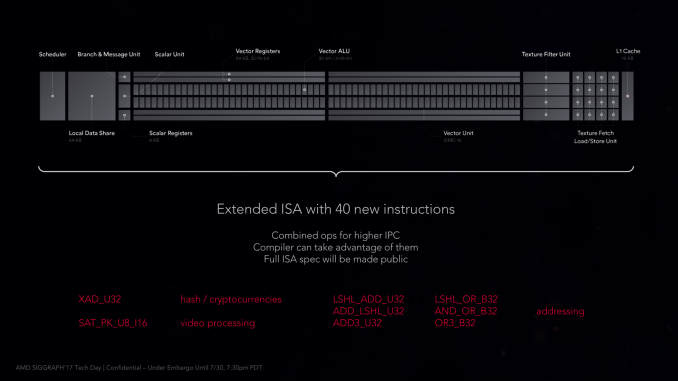The AMD Radeon RX Vega 64 & RX Vega 56 Review: Vega Burning Bright
by Ryan Smith & Nate Oh on August 14, 2017 9:00 AM ESTThe Vega Architecture: AMD’s Brightest Day
From an architectural standpoint, AMD’s engineers consider the Vega architecture to be their most sweeping architectural change in five years. And looking over everything that has been added to the architecture, it’s easy to see why. In terms of core graphics/compute features, Vega introduces more than any other iteration of GCN before it.
Speaking of GCN, before getting too deep here, it’s interesting to note that at least publicly, AMD is shying away from the Graphics Core Next name. GCN doesn’t appear anywhere in AMD’s whitepaper, while in programmers’ documents such as the shader ISA, the name is still present. But at least for the purposes of public discussion, rather than using the term GCN 5, AMD is consistently calling it the Vega architecture. Though make no mistake, this is still very much GCN, so AMD’s basic GPU execution model remains.
So what does Vega bring to the table? Back in January we got what has turned out to be a fairly extensive high-level overview of Vega’s main architectural improvements. In a nutshell, Vega is:
- Higher clocks
- Double rate FP16 math (Rapid Packed Math)
- HBM2
- New memory page management for the high-bandwidth cache controller
- Tiled rasterization (Draw Stream Binning Rasterizer)
- Increased ROP efficiency via L2 cache
- Improved geometry engine
- Primitive shading for even faster triangle culling
- Direct3D feature level 12_1 graphics features
- Improved display controllers
The interesting thing is that even with this significant number of changes, the Vega ISA is not a complete departure from the GCN4 ISA. AMD has added a number of new instructions – mostly for FP16 operations – along with some additional instructions that they expect to improve performance for video processing and some 8-bit integer operations, but nothing that radically upends Vega from earlier ISAs. So in terms of compute, Vega is still very comparable to Polaris and Fiji in terms of how data moves through the GPU.
Consequently, the burning question I think many will ask is if the effective compute IPC is significantly higher than Fiji, and the answer is no. AMD has actually taken significant pains to keep the throughput latency of a CU at 4 cycles (4 stages deep), however strictly speaking, existing code isn’t going to run any faster on Vega than earlier architectures. In order to wring the most out of Vega’s new CUs, you need to take advantage of the new compute features. Note that this doesn’t mean that compilers can’t take advantage of them on their own, but especially with the datatype matters, it’s important that code be designed for lower precision datatypes to begin with.











213 Comments
View All Comments
Makaveli - Monday, August 14, 2017 - link
https://www.newegg.ca/Product/ProductList.aspx?Sub...Air cooled Vega 64 for $839 CAD I don't think so.
When you can pay $659 CAD for the 1080?
I prefer AMD cards over NV but even I'm not dumb enough to do this.
$180 extra for the same performance and must higher heat output.
mapesdhs - Monday, August 14, 2017 - link
That was exactly my point, real pricing is way out of whack for the Vega64 to make any sense atm. Can you check, is it possible to buy a 1080 Ti for the same price as the cheapest Vega64/Liquid? This is the case in the UK, where the 64/Liquid is basically 700 UKP, same as a Palit Jetstream 1080 Ti.Makaveli - Monday, August 14, 2017 - link
@mapesdhsLiquid Vega 64 is $979 CAD
1080 TI air is in the $924-$984 CAD.
Liquid 1080 Ti's are in the $1,014-$1,099 range.
And the 1080 Ti will still be faster and using less power....
zodiacfml - Monday, August 14, 2017 - link
AMD is truly an underdog. Fighting Nvidia and Intel at the same time but I could see that they are doing their best based on their designs. Their unique position is what made them successful in gaming consoles. Can't wait to see the performance of Raven Ridge parts.Frenetic Pony - Monday, August 14, 2017 - link
Regarding FP16 game use, Devs are already using it because it's supported on the PS4 Pro. While the specific "Checkerboard" rendering used in Mass Effect Andromeda and Battlefield 1 are PS4 Pro only due to hardware oddities, it still uses FP16 optimizations. And since both PS4 and Xbox One have FP16 register capabilities it's an easy target for optimization there, and easy to bring over to PC.Frankly I'd expect it to be adopted fairly quickly. Register pressure alone is reason enough for high end games to call for explicit FP16 where applicable, and porting such to the PC is relatively easy.
BaroMetric - Monday, August 14, 2017 - link
Vega is already sold out and the bundles on newegg require you buy gpu, cpu, mobo etc. You can't just pay the extra hundred dollars you actually have to purchase the other components. Which is not what we were lead to believeAzix - Tuesday, August 15, 2017 - link
need to include clock speed profiles. should be basic information reviewers include nowadays. put performance in context. This is nearly useless without it.Ryan Smith - Friday, August 18, 2017 - link
Ask and you shall receive. Check the power/temp/noise page.=)HollyDOL - Tuesday, August 15, 2017 - link
It was all good... until I reached power consumption/noise part of the review.Outlander_04 - Tuesday, August 15, 2017 - link
Now go and work out what that extra power will cost you if you game 2 hours a day for a year.The answer is NOTHING if you heat your house with a thermostat controlling temps,
And a very small amount if you don't.
Now go turn off a couple of lights. You know you want to.